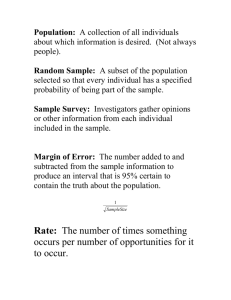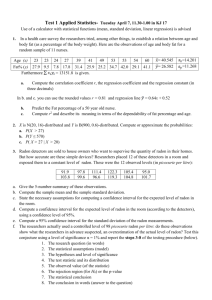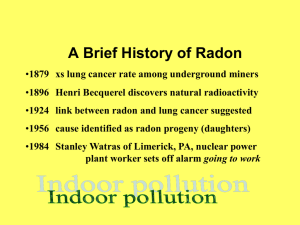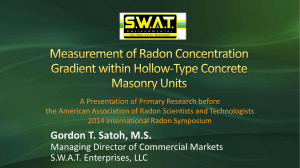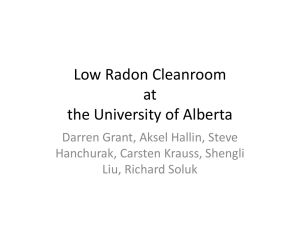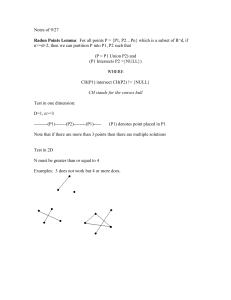Auxiliary material for
advertisement
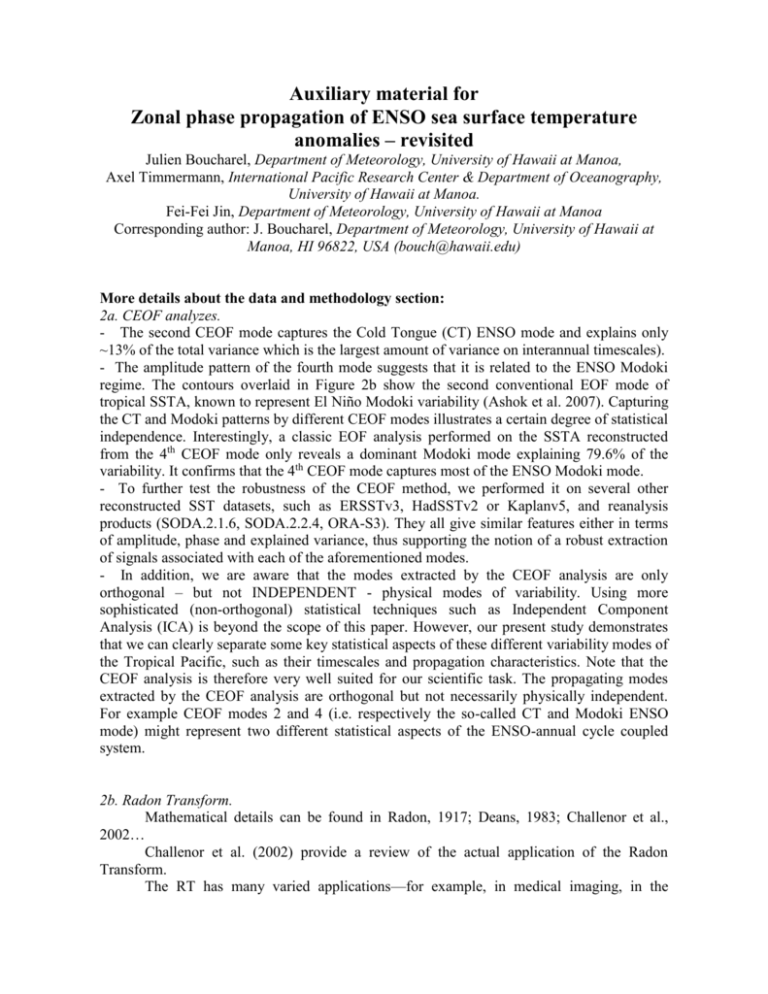
Auxiliary material for Zonal phase propagation of ENSO sea surface temperature anomalies – revisited Julien Boucharel, Department of Meteorology, University of Hawaii at Manoa, Axel Timmermann, International Pacific Research Center & Department of Oceanography, University of Hawaii at Manoa. Fei-Fei Jin, Department of Meteorology, University of Hawaii at Manoa Corresponding author: J. Boucharel, Department of Meteorology, University of Hawaii at Manoa, HI 96822, USA (bouch@hawaii.edu) More details about the data and methodology section: 2a. CEOF analyzes. - The second CEOF mode captures the Cold Tongue (CT) ENSO mode and explains only ~13% of the total variance which is the largest amount of variance on interannual timescales). - The amplitude pattern of the fourth mode suggests that it is related to the ENSO Modoki regime. The contours overlaid in Figure 2b show the second conventional EOF mode of tropical SSTA, known to represent El Niño Modoki variability (Ashok et al. 2007). Capturing the CT and Modoki patterns by different CEOF modes illustrates a certain degree of statistical independence. Interestingly, a classic EOF analysis performed on the SSTA reconstructed from the 4th CEOF mode only reveals a dominant Modoki mode explaining 79.6% of the variability. It confirms that the 4th CEOF mode captures most of the ENSO Modoki mode. - To further test the robustness of the CEOF method, we performed it on several other reconstructed SST datasets, such as ERSSTv3, HadSSTv2 or Kaplanv5, and reanalysis products (SODA.2.1.6, SODA.2.2.4, ORA-S3). They all give similar features either in terms of amplitude, phase and explained variance, thus supporting the notion of a robust extraction of signals associated with each of the aforementioned modes. - In addition, we are aware that the modes extracted by the CEOF analysis are only orthogonal – but not INDEPENDENT - physical modes of variability. Using more sophisticated (non-orthogonal) statistical techniques such as Independent Component Analysis (ICA) is beyond the scope of this paper. However, our present study demonstrates that we can clearly separate some key statistical aspects of these different variability modes of the Tropical Pacific, such as their timescales and propagation characteristics. Note that the CEOF analysis is therefore very well suited for our scientific task. The propagating modes extracted by the CEOF analysis are orthogonal but not necessarily physically independent. For example CEOF modes 2 and 4 (i.e. respectively the so-called CT and Modoki ENSO mode) might represent two different statistical aspects of the ENSO-annual cycle coupled system. 2b. Radon Transform. Mathematical details can be found in Radon, 1917; Deans, 1983; Challenor et al., 2002… Challenor et al. (2002) provide a review of the actual application of the Radon Transform. The RT has many varied applications—for example, in medical imaging, in the processing of seismic data to find subsurface rock interfaces, and in the detection of ship wakes in satellite images. In the oceanographers’ community, this tool has mostly been applied to satellite remote sensing data, particularly for the detection and estimation of Rossby waves speed (Chelton and Schlax, 1996; Polito and Cornillion, 1997; Cipollini et al., 1997, 1999; Challenor et al., 2002). In practice, we project the Hovmöller diagram denoted f(t,x) (e.g Figure fs01a) onto a series of lines at various angles varying from 0° (the time t-axis) to 180° (the longitude xaxis being at 90°) and for different times t’. The Radon transform p(t’,) is defined as, p(t', ) f (t, x) t t' cos x' sin dx' . x' x t' sin x' cos When the line (t'cos x'sin ; t'sin x'cos ) in the 2-dimensional space t-x is perpendicular to crests (positive El Niño anomalies) and troughs (negative La Niña anomalies), the projection will have maximum so-called “Radon energy” (i.e. maximum variance). The integral is calculated over the entire longitudinal domain. Thus to find the speed (travel line in the 2D space-longitude diagram), we determine the dominant phase projection that gives maximum variance and identify the corresponding angle θ that is perpendicular to that projection. Mathematically, this is expressed by finding the value θ, for which RE f p 2 (t', )dt' attains a maximum value. The geometric meaning of the variables is illustrated in Figure fs01. Knowing the zonal extent and the time resolution of the Hovmöller plot f, it is straightforward to translate the value θ into a phase speed vφ (the relationship is displayed in Figure fs01b for the HadISST product). At this point, we notice that the definition of an angle needs a reference line (the time t-axis) and a reference origin. In our case, we choose the centre of the Hovmöller map f. Therefore, the centre line of the corresponding RT will give the Radon energy at each angle between 0° and 180° at these particular time and longitude (not shown). Figure fs01. a) f(t,x) 2D space-time diagram. b) Relationship between angles and phase speed for HadISST dataset size and resolution. Application of the Radon Transform on a simple propagation case: For purposes of illustration, we calculate the Radon Transform for a simple case. f (x,t) sin( kx t) (k, ) (k1,1) for first half of the record (k, ) (k2 , 2 ) forsec ond half of the record Figure fs02. f(x,t): 2D space-time simple propagation case. (k1,1) and (k2,2) are set to correspond respectively to 1 = 47° and 2 = 153° (with the time axis as a reference) Let’s apply the Radon Transform on this simple case (the whole f(t,x) map displayed in Figure fs02) to identify the angles/phase speed on this diagram. Results of RT are displayed in Figure fs03. The RT allows identifying angles around 1 = 47° over the first half of the map and 2 = 153° over the second half. The Figure fs04 displays the Probability Density Function (PDF) of the most significant angles θsignif (i.e. whose Radon energy RE f p 2 (t', )dt' is above a certain threshold, defined as a fraction of the maximum Radon energy, max[REf]). This leads to an accurate estimation of the angles/phase speed in this diagram. However, we can observe a loss of Radon energy on both edges of the f(t,x) diagram leading to an unrealistic estimation of the time evolution of the significant angles/phase speed. Figure fs03. Radon Transform (Variance) of the input data displayed in Figure fs01. Figure fs04. Detection of significant angles in the f(t,x) diagram, for which the Radon energy exceeds 0.67 max [REf]. To resolve this issue, we perform a running RT (RRT) in the temporal dimension on the same input map f(t,x). In other words, we apply the same RT diagnostic but on a smaller part of the diagram (corresponding in this case to a sliding temporal window of 25 occurrences, see Figure fs05), and we only retain the RT value (for each angle) at the centre of the window (thus eliminating probable inaccurate values over both edges of the RT). The reconstructed RT of the full map f(t,x) is displayed in Figure fs06. There is no longer loss of signal on the edges of the diagram. Nevertheless, we observe a loss in the estimation accuracy, such as indicated in Figure fs07 which exhibit the most significant angles θsignif of f(t,x) diagram. Note that the spread of the PDF will directly depend on the length of the sliding window. Figure fs05. f(x,t): 2D space-time simple propagation case. (k1,1) and (k2,2) are set to correspond respectively to 1 = 47° and 2 = 153° (with the time axis as a reference) Figure fs06. Running Radon Transform of the input data displayed in Figure fs01. Figure fs07. Detection of significant angles in the f(t,x) diagram, for which the Radon energy exceeds 0.67 max [REf]. In order to assess the temporal evolution of the dominant angle/phase speed, we then retain the most energetic angle at the centre of the RT map (corresponding to the time-step in the middle of the sliding window, t’=0 on Figure fs03). The time evolution of the dominant angle (which maximizes REf at each time-step) is displayed in Figure fs08. Figure fs08. Detection of the most significant angle in the f(t,x) diagram at each time-step. The RRT method gives very accurate estimation of angles (and therefore phase speed) on this simplified example of wave propagation. In our study we apply the RRT on 2dimensional Hovmoller diagrams of sea surface temperature along the equator. This will enable us to determine phase propagation speed time series at each longitude of f (in this particular case, the previous integral is calculated over the length of the longitudinal sliding window). We tried different windows’ sizes both in the temporal and longitudinal domains. The results were consistent among the different windows combinations tested. We chose a 5years temporal sliding window along with a 100° spatial sliding window. We present results integrated over the longitudinal domain 170°W-110°W, encompassing the centers of action of the different modes. Challenor, P. G., P. Cipollini, and D. Cromwell, 2002: Use of the 3D Radon transform to examine the properties of oceanic Rossby waves (vol 18, pg 1558, 2001). Journal of Atmospheric and Oceanic Technology, 19, 828-828. Cipollini, P., D. Cromwell, and G. D. Quartly, 1999: Observations of Rossby Wave propagation in the Northeast Atlantic with TOPEX/POSEIDON altimetry. Adv. Space Res., 22, 1553–1556. Cipollini, P., D. Cromwell, M. S. Jones, G. D. Quartly, and P. G. Challenor, 1997: Concurrent TOPEX/POSEIDON altimeter and Along-Track Scanning Radiometer observations of Rossby wave propagation near 348N in the northeast Atlantic. Geophys. Res. Lett., 24, 889– 892. Deans, S.R. (1983). "The Radon Transform and Some of Its Applications." John Wiley and Sons, 289 pp. Polito, P. S., and P. Cornillon, 1997: Long baroclinic Rossby waves detected by TOPEX/POSEIDON. J. Geophys. Res., 102, 3215– 3235. Radon, J., (1917). "Über die Bestimmung von Funktionen durch ihre Integralwerte längs gewisser Mannigfaltigkeiten." Math.-Phys. Kl., 69, 262–267. [For English translation, see Deans (1983), 204– 217].


